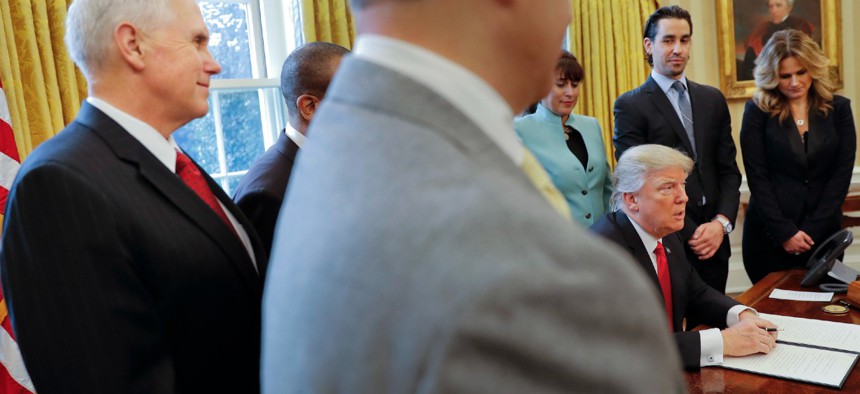Watchdog: Results of Trump’s Deregulatory Executive Orders Could Be ‘Overstated’
Biden’s repeal of the directives won’t cause “disruptions or major changes going forward,” GAO finds.
The effects of President Trump’s much-championed regulatory rollback executive order may have been “overstated,” a watchdog said on Monday.
The Government Accountability Office published a report on Monday based on its review of three deregulatory executive orders issued under the Trump administration. One required two regulations to be rolled back for every new one issued; another mandated that agencies establish a task force and designate an officer to implement the previous one; and the last one directed agencies to waive or modify any regulations that could impede economic recovery from the recession created by the COVID-19 pandemic. President Biden revoked all three. GAO’s report focuses on the Commerce, Homeland Security, Interior and Transportation departments and Environmental Protection Agency because they implemented more than half of the regulatory actions under the first executive order.
“According to [the Office of Information and Regulatory Affairs] report, Final Accounting for Fiscal Year 2020, collectively the federal government met the two primary goals established and defined in EO 13771 by implementing more than the established goal of two deregulatory actions for every new regulatory action, and, achieving net savings,” GAO said. “OIRA reported that the selected agencies implemented 286 deregulatory actions (for a ratio of 9:1 deregulatory to regulatory actions), and that these actions were estimated to have annual savings in perpetuity of almost $160 billion. However, this analysis reflects some methodological decisions that may have overstated the reported results of the deregulatory EOs.”
This was because OIRA compared all deregulatory actions to only significant regulatory ones that resulted “in a $100 million or greater effect on the economy in any given year” or met other criteria, GAO said. The report does not say why OIRA chose this method. As a result, the true effects of Trump’s deregulatory executive orders are unknown as OIRA stopped its review of agencies’ compliance with them after Biden revoked them.
GAO also reported that only select agencies used a few alternative regulatory actions to meet the Trump administration’s deregulation goals, as allowed by the Office of Management and Budget, which houses OIRA. For example, in March 2017 the Interior Secretary revoked a guidance document about the use of non-toxic ammunition and fish tackle, arguing that it wasn’t required by any regulatory requirement and stakeholders weren’t consulted in the development of it.
As for the pandemic, all five of the agencies used alternative actions, but OIRA didn’t track all of them.
Officials from the five agencies said the regulatory executive orders didn’t cause “substantive changes to the agencies’ normal regulatory processes and procedures,” so Biden’s revocation of them won’t cause major changes going forward, said the watchdog.
This is not the first report about the lack of overwhelming success from Trump’s much-championed deregulatory actions.
In November 2020, professors from Rutgers University and the University of Pennsylvania published a report that stated Trump’s claims about economic gains and job growth from his deregulatory efforts were “a mix of exaggerated, cherry-picked and indefensible” statements.
In response to the GAO report, Amit Narang, regulatory policy advocate at Public Citizen, a consumer advocacy group, said in a tweet that the two-for-one executive order “was bad policy;” however, there are “still better than even odds it comes back under the next GOP president.”
President Biden has not had the same penchant for getting rid of regulations. Rather, he uses them to further his goals, such as helping small businesses, advancing equity and curbing climate change. However, he has yet to name nominees to lead OMB and OIRA.








